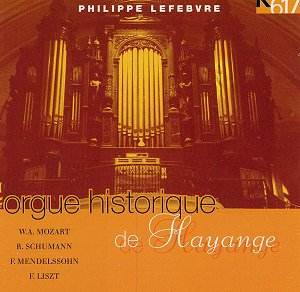The booklet notes
to this release pay sentimental tribute to the art of organ building
and restoration. The story of the historic Opus 100 Dalstein-Haerpfer
organ in Hayange (Moselle)is affectionately related from
its origins in 1895 through its steady decline to its present-day restoration.
As heard on this well-recorded disc, it is evidently an instrument capable
of much power and also much beauty.
The accompanying essay (in an uncredited and clumsy translation) is
entitled 'The Organ between Baroque and Romanticism', reflecting this
disc's journey from Mozart through to the extravagant gestures of Liszt.
The organ was not the compositional instrument of choice for any of
these four composers and, indeed, The Mozart Fantasia and the Schumann
Esquisses were not even intended for it.
Philippe Lefebvre
is, on this showing, an accomplished musician with a keen sense of style.
This is heard straight away in the Mozart, a delightful performance:
listen to the pulsating left hand accompaniment with syncopated right
hand against it: Lefevbre achieves just the right ambience.
K617's superb
recording really begins to register with Mendelssohn's Three Preludes
and Fugues, Op. 37 (composed between 1833 and 1837, and dedicated to
Thomas Attwood, then organist of St
Paul's,
London). Mendelssohn, indeed, composed
a surprising corpus of music for the organ (try the two-disc set on
Hyperion CDA66491/2 for further exploration). The gravitas of No. 1
in C and No. 3 in D minor is played off by No. 2 in G, with its rocking
Prelude [QUOTE: Track 3, Opening]. The fugue remains, however, imposingly
serious.
Schumann's pleasant
Esquisses, Op. 58 work well, with the capacity for effective contrast
well utilised. The C major, Op. 58 No. 2 shoes definite leanings towards
the celebrational [QUOTE: Track 6, Opening]. The final Esquisse, in
D minor is, notwithstanding its use of the minor, a playful way to end
the set.
At over thirteen
minutes, Liszt's Prelude and Fugue on BACH S260, of 1855/6, makes for
an appropriate climax to the programme. Evidently inspired by the concept
of paying homage to The Master, Liszt's piece is virtuoso in intent,
not only in terms of technical difficulty but also in sheer range of
expressivity. Lefebvre clearly has the measure of this great work (QUOTE
Opening). He is, indeed, no mean instrumentalist (he was organist in
Ozawa's recording of Saint-Saens' Third Symphony for EMI with the Paris
National Orchestra).
Wholeheartedly recommended.
Colin Clarke
